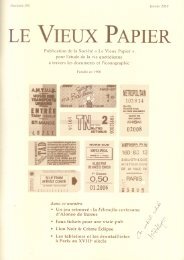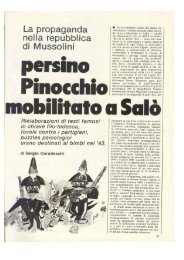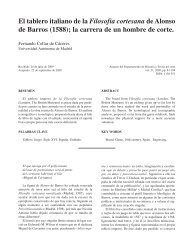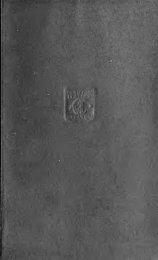Board games from the city of Vijayanagara (Hampi ... - Gioco dell'Oca.
Board games from the city of Vijayanagara (Hampi ... - Gioco dell'Oca.
Board games from the city of Vijayanagara (Hampi ... - Gioco dell'Oca.
Create successful ePaper yourself
Turn your PDF publications into a flip-book with our unique Google optimized e-Paper software.
18<br />
B OARD G AME S TUDIES 6, 2003<br />
ily <strong>of</strong> ball <strong>games</strong>. It is not an extinct game, however; recently it has seen a renaissance in<br />
Istria, being played as a tournament game by Slovenian and Croatian players. (36)<br />
I have recently learned <strong>of</strong> a highly unusual type <strong>of</strong> stick game, in which <strong>the</strong> stick at<br />
<strong>the</strong> same time functioned as a die. In his book So i hul <strong>from</strong> 1990 <strong>the</strong> Danish game historian<br />
Jørn Møller describes a game <strong>of</strong> this type, a Faroese 18th-century game called<br />
exebiti. (37) I have now discovered that <strong>the</strong> same tradition was known also along <strong>the</strong><br />
Norwegian coast <strong>from</strong> Oslo to a little north <strong>of</strong> Bergen, in Belgium, and in Scotland.<br />
Apparently no parallel occurrences have been found at all. (38)<br />
The dice stick used in <strong>the</strong>se <strong>games</strong> is a 10-12 cm long and a 1 1/2 to 3 cm wide rectangular<br />
piece <strong>of</strong> wood with pyramidal ends and Roman numerals cut into its four<br />
sides. In Bergen shorter and thicker sticks are sometimes preferred. The rules differ<br />
quite a bit. Only a few common features will be mentioned here. In most cases <strong>the</strong><br />
stick is placed upon an oblique board, and a circle on <strong>the</strong> ground is made around it. Two<br />
players or teams participate: one is in, one is out. The in-team hits <strong>the</strong> dice stick in<br />
turn with a bat or rod on <strong>the</strong> point <strong>of</strong> it, thus making it whirl through <strong>the</strong> air. In some<br />
<strong>of</strong> <strong>the</strong> Norwegian variants it is first thrown in <strong>the</strong> direction <strong>of</strong> <strong>the</strong> circle. When <strong>the</strong><br />
stick is hit, <strong>the</strong> out-team tries to catch it or throw it back into <strong>the</strong> circle. If <strong>the</strong>y succeed,<br />
<strong>the</strong>n <strong>the</strong> roles are reversed.<br />
The nixepinne used in Oslo (39) and Kristianssand, (40) <strong>the</strong> katt used in Lista, (41) and<br />
<strong>the</strong> kattepinne used in Bergen and Dale (42) all have <strong>the</strong> same signs on <strong>the</strong>ir sides: an X or<br />
a cross and <strong>the</strong> Roman numerals II, IIII and VI. The cat used in <strong>the</strong> game strac agus cat,<br />
played in Argyleshire, in South-Western Scotland, had <strong>the</strong> Roman numerals I, II, III, IV<br />
on its sides. (43) The Faroese exebiti, described by Johan Christian Svabo in his<br />
Indberetninger, that is reports <strong>from</strong> a journey in 1781 and 1782, has o<strong>the</strong>r signs: <strong>the</strong><br />
Roman numerals I, II, X and XII. (44)<br />
The South-West Norwegian abeseditt<br />
<strong>from</strong> Valestrand has <strong>the</strong> (Roman?)<br />
numbers 100, 50, 20 and 10. (45) Similar<br />
values are known <strong>from</strong> West Flanders. (46)<br />
The wiep used in <strong>the</strong> game wiep-slaan has<br />
<strong>the</strong> (Roman?) numbers 100, 50, 25 and<br />
<strong>the</strong> word wiep, or as an abbreviation, <strong>the</strong><br />
letter W. The similar stick used in<br />
Fig. 12. Sticks for <strong>the</strong> Flemish game duzendslaan!<br />
A indicates <strong>the</strong> 10 cm long dice stick<br />
which is to be hit, B <strong>the</strong> 1,25 m long stick,<br />
put into <strong>the</strong> ground, C. (Drawing in de<br />
Cock and Tierlinck 1903).<br />
duzend-slaan (Fig. 12) had <strong>the</strong> following<br />
signs: 10 crosses, meaning 100, 5 crosses,<br />
meaning 50, <strong>the</strong> Roman numeral 25 and<br />
niets, that is “nothing” (sometimes<br />
marked with a cross or V).<br />
The numbers 2, 4, 6, on <strong>the</strong><br />
Norwegian nixepinne, katt and kattepinne decide <strong>the</strong> number <strong>of</strong> strokes that one <strong>of</strong> <strong>the</strong><br />
two teams is entitled to make. When <strong>the</strong> dice stick lands outside <strong>the</strong> circle, <strong>the</strong>n, when<br />
nixepinne is being played, <strong>the</strong> in-team is allowed to strike and, when katt and kattepinne<br />
are being played, <strong>the</strong> out-team may strike. Should <strong>the</strong> kattepinne rest on <strong>the</strong> circle, only







